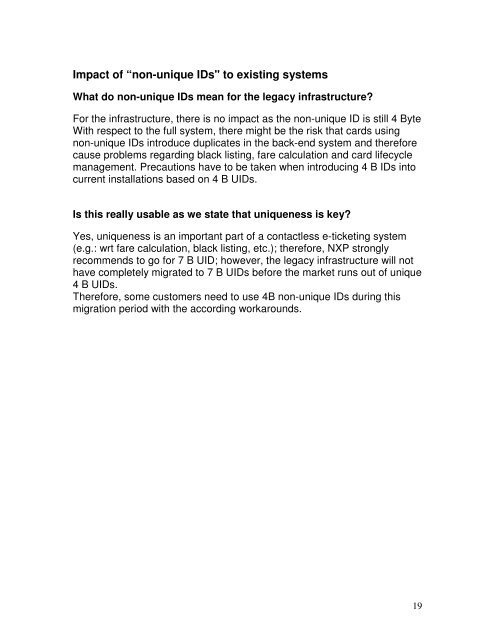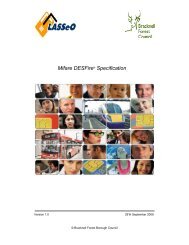4 Byte and 7 Byte UID offering for MIFARE Classic™, MIFARE Plus ...
4 Byte and 7 Byte UID offering for MIFARE Classic™, MIFARE Plus ...
4 Byte and 7 Byte UID offering for MIFARE Classic™, MIFARE Plus ...
You also want an ePaper? Increase the reach of your titles
YUMPU automatically turns print PDFs into web optimized ePapers that Google loves.
Impact of “non-unique IDs" to existing systems<br />
What do non-unique IDs mean <strong>for</strong> the legacy infrastructure?<br />
For the infrastructure, there is no impact as the non-unique ID is still 4 <strong>Byte</strong><br />
With respect to the full system, there might be the risk that cards using<br />
non-unique IDs introduce duplicates in the back-end system <strong>and</strong> there<strong>for</strong>e<br />
cause problems regarding black listing, fare calculation <strong>and</strong> card lifecycle<br />
management. Precautions have to be taken when introducing 4 B IDs into<br />
current installations based on 4 B <strong>UID</strong>s.<br />
Is this really usable as we state that uniqueness is key?<br />
Yes, uniqueness is an important part of a contactless e-ticketing system<br />
(e.g.: wrt fare calculation, black listing, etc.); there<strong>for</strong>e, NXP strongly<br />
recommends to go <strong>for</strong> 7 B <strong>UID</strong>; however, the legacy infrastructure will not<br />
have completely migrated to 7 B <strong>UID</strong>s be<strong>for</strong>e the market runs out of unique<br />
4 B <strong>UID</strong>s.<br />
There<strong>for</strong>e, some customers need to use 4B non-unique IDs during this<br />
migration period with the according workarounds.<br />
19









